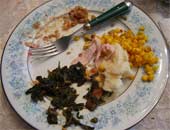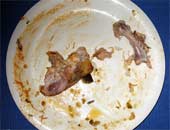Pick your plate
 |
 |
 |
If we put dilution and scaling up together, we can estimate the number of bacteria in the original sample. For example:
If a 1:10,000 dilution results in a plate with 176 CFUs, then the original number of bacteria in the sample?
(To make this problem interactive, turn on javascript!)
- I need a hint ... : Remember you have basically counted 1/10,000th of the original bacteria.
- ...another hint ... : Multiply by the reciprocal of the dilution factor
- ...one more hint ... : Don't forget that we're only reporting 2 significant digits.
I think I have the answer: approximately 1,800,000.
Pretty easy, right? The only tricky part is that you don't know in advance how far to dilute your original sample. Let's see what happens if you always count a 1:10,000 diluted sample. If your original solution contained...
- 50,000,000 bacteria: the 1:10,000 sample will contain about 5,000 CFUs. You would be counting all day (and the CFUs overlap and it's a mess).
- 500,000 bacteria: the diluted sample will contain about 50 CFUs, which is both easy to count and valid for scaling up.
- 50,000 bacteria: the diluted sample will contain ON AVERAGE 5 CFUs. But remember that diluting and sampling is bascially a random process, and imagine the havoc caused by one extra CFU ending up in your pipette -- suddenly you estimate the population as 60,000 rather than 50,000, and you're off by 20%.
- 5000 bacteria: the diluted sample will contain ON AVERAGE 0.5 CFUs -- meaning that any given sample will probably contain either 0 or 1 CFU. This will be easy to count, but its not valid for scaling up.
So here's the general rule: in order to be valid, the plate that you scale up should contain between 25 and 250 CFUs. Any more than 250 CFUs can cause overlap, and you'll underestimate the population size. Any fewer than 25 makes your estimate vulnerable to over- OR under-estimates based on random chance alone.
So the real trick here is picking the correct dilution. For the 50 million bacteria case, 1:1,000,000 would have been a good dilution facter. For the 5 thousand bacteria case, 1:100 would have done the trick. And since you can't know ahead of time what that is, instead you'll need a series of dilutions.
A series of dilutions ensures that one of these dilutions will be in the countable range (25 to 250 CFUs).
Copyright University of Maryland, 2007
You may link to this site for educational purposes.
Please do not copy without permission
requests/questions/feedback email: mathbench@umd.edu